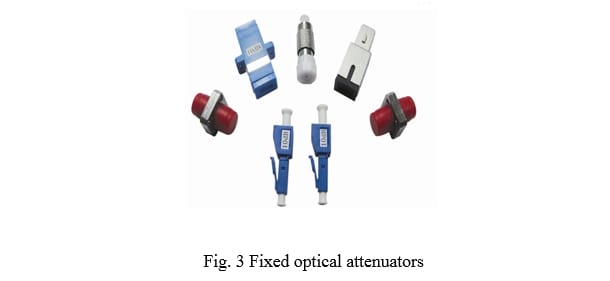The Basics: Optical attenuators
An optical attenuator is a passive device that is used to reduce the power level of an optical signal. The attenuator circuit will allow a known source of power to be reduced by a predetermined factor, which is usually expressed as decibels. Optical attenuators are generally used in single-mode long-haul applications to prevent optical overload at the receiver.
Optical attenuator typically comes in two forms of packaging. The bulkhead optical attenuator shown in Fig. 1 can be plugged into the receiver receptacle. The inline attenuator shown in Fig. 2 resembles a patch cord and is used between the patch panel and the receiver.

The principle of gap-loss is used in optical attenuators to reduce the optical power level by inserting the device in the fiber path using an inline configuration. Gap-loss attenuators are used to prevent the saturation of the receiver and are placed close to the transmitter.
The absorptive principle, or absorption, accounts for a percentage of power loss in optical fiber. This loss is realized because of imperfections in the optical fiber that absorb optical energy and convert it to heat.
The reflective principle, or scattering, accounts for the majority of power loss in optical fiber and again is due to imperfections in the optical fiber, which in this case cause the signal to scatter.
Fixed Attenuators
Fixed attenuators are designed to have a fixed attenuation level. They can theoretically be designed to provide any amount of attenuation that is desired. The output signal is attenuated relative to the input signal. Fixed attenuators are typically used for single-mode applications. Fig. 3 shows fixed optical attenuators.

Stepwise Variable Attenuators
A stepwise variable attenuator is a device that changes the attenuation of the signal in known steps such as 0,1 dB, 0,5 dB, or 1 dB. The stepwise attenuator may be used in several applications when dealing with multiple power sources – for example, if there are three inputs available, there may be a need to attenuate the signal at a different level for each of the inputs.
Continuously Variable Attenuators
A continuously variable attenuator is an attenuator that can be changed on demand. These attenuators generally have a device in place that allows the attenuation of the signal to change on demand. Continuously variable attenuator is used in uncontrolled environments where the input characteristics and/or output needs continually change. This allows the operator to adjust the attenuator to accommodate the changes required quickly and precisely without any interruption to the circuit.
Calculating the Attenuation Value
There are many types of attenuators and many principles on which they work. The key to choosing the appropriate one is to understand the theory on which each operates and the application that the attenuator will be applied to. Of course, you also need to be able to determine the attenuator value in decibels required for your application.
In this example let’s assume that the maximum optical input power a fiber-optic receiver can operate with is -6dBm. If the input power exceeds this power level, the receiver will be overloaded. The transmitter, which is located 10 km from the receiver, has an output power of 3dBm. The loss for 10 km of optical fiber, including interconnections, is 5dB.
To calculate the minimum attenuation required to prevent the receiver from being overloaded, we need to subtract all the known losses from the output power of the transmitter as shown here:
Transmitter power (TP) = 3dBm
Receiver maximum optical input power (MP) = -6dBm
Total losses (TL) = 5dB
Minimum attenuation required = MP + TL – TP = -6dBm + 5dB – 3dBm = – 4 dB
At a minimum, a 4 dB attenuator is required. However, an attenuator with a larger value could be used as long as it did not over attenuate the signal.
If any other questions, please do not hesitate to contact Us!

